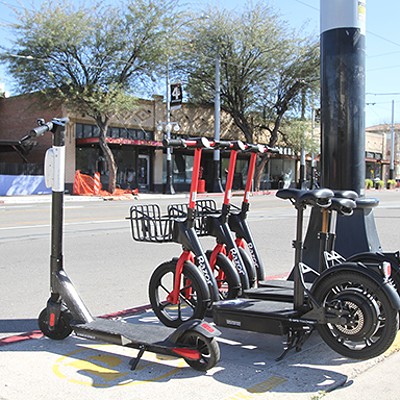When voters approved the county's transportation bond package in 1997, one of the 57 projects was widening the two-plus miles of Craycroft Road between River Road and Sunrise Drive to four lanes. A total of $12 million was set aside for the improvement, and it was scheduled to be completed by 2005.
Due to programming delays and cost increases, the project is still being discussed. Currently, as 18,000 cars a day zip along Craycroft at 45 mph or more, passing large homes and lush desert vegetation, the scenic road remains two lanes.
But plans are underway to change that. A Citizen Advisory Committee has been meeting to choose between two primary options. One would implement the four-lane divided roadway design, the other a three-lane street with a center turn lane.
It's estimated that the four-lane option would cost almost $17 million and require 78 feet of pavement. The three-lane alternative is 30 feet narrower and about $4 million cheaper.
Earlier this year, project engineer Salvatore Caccavale said the goals of the roadway widening were three-fold: to accommodate the expected traffic in 2025, to be fiscally responsible while remaining within the budget and to minimize the environmental impacts on the area.
To determine the travel efficiency of the two widening options, a pair of studies was conducted for Pima County, both of which arrived at the same conclusion: While the four-lane road could obviously carry more cars, three lanes will be enough to accommodate the expected daily traffic volume of 25,000 vehicles in 2025.
As one of the consultant-prepared reports states, "On this section of Craycroft Road, a three-lane section will provide an acceptable level of service and enhanced access safety through 2025."
With guaranteed funding for the project now at $13 million, and with fewer environmental impacts in addition to an acceptable traffic flow provided by the three-lane alternative, Shapiro assumed it would be the obvious choice. But then, he experienced political reality: The Pima County Board of Supervisors and the 10-member citizens committee unanimously lined up in support of the wider, more expensive option.
Supervisor Ann Day, who represents the area, recently told the committee that County Administrator Chuck Huckelberry promised he would find the required $4 million. Huckelberry later indicated these extra funds would come from impact fees, cost savings from other roadway bond projects and additional sources.
Despite the conclusion of the two traffic studies, Day said, "The county feels because of the capacity needed by 2025, we need four lanes. The three-lane option doesn't make much sense. The project scope study showed four lanes was the most efficient and safest."
Citizen committee chair Charles Geoffrion also stressed the safety issue as his primary reason for supporting the four-lane alternative.
"I started this process believing that three lanes were better," Geoffrion said at the last committee meeting, "but my conclusion now is the only way to make the roadway safe is to separate north(bound) from southbound traffic. The tradeoff is safety verses the environment."
Caccavale says those views on traffic safety are more perception than reality, in part because the wider street will result in higher speeds.
"There is nothing in terms of design standards to say a four-lane street is safer," he states. "The three-lane safety record is very good. Drivers are not protected by a median (on those streets), but they have better control of their speeds. I don't think anything says one is safer than another."
In a recent letter to Shapiro, County transportation Director Kurt Weinrich listed two other reasons for backing the four-lane option. First, it would match the number of existing travel lanes south of River Road and the design he projects will be implemented north of Sunrise Drive by 2025.
But, Weinrich wrote, most importantly, "the county is committed to deliver to the public what was promised in the 1997 ... election," a sentiment echoed by both Day and Geoffrion.
While Tucson residents may be surprised by that statement--since they've received very little from the '97 bond package--Shapiro is dumfounded by the county's decision. He has calculated that drivers at most will save 90 seconds in their drives for the extra millions of dollars being spent. He also points to the greater environmental damage the wider roadway will inflict, and the fact that the county wouldn't have to rob Peter to pay Paul to build the narrower project.
As for the argument that voters were promised four lanes in 1997, Shapiro calls that a lemming attitude.
"The situation has changed," he says, "but you go over the cliff anyway?"
While he originally thought of launching a petition campaign against the four-lane roadway, Shapiro now says he is discouraged and not sure the effort is worth the energy.
Meanwhile, plans for widening the road beginning in early 2006 roll along, but more problems may have already appeared. The adequacy of the county's cost estimate for four lanes has been questioned, along with the project's omission of sound walls. Plus, Shapiro's wife says she has seen pygmy owls on their property near Craycroft Road, which might put a damper on things.
The controversy over the widening seems far from finished.











